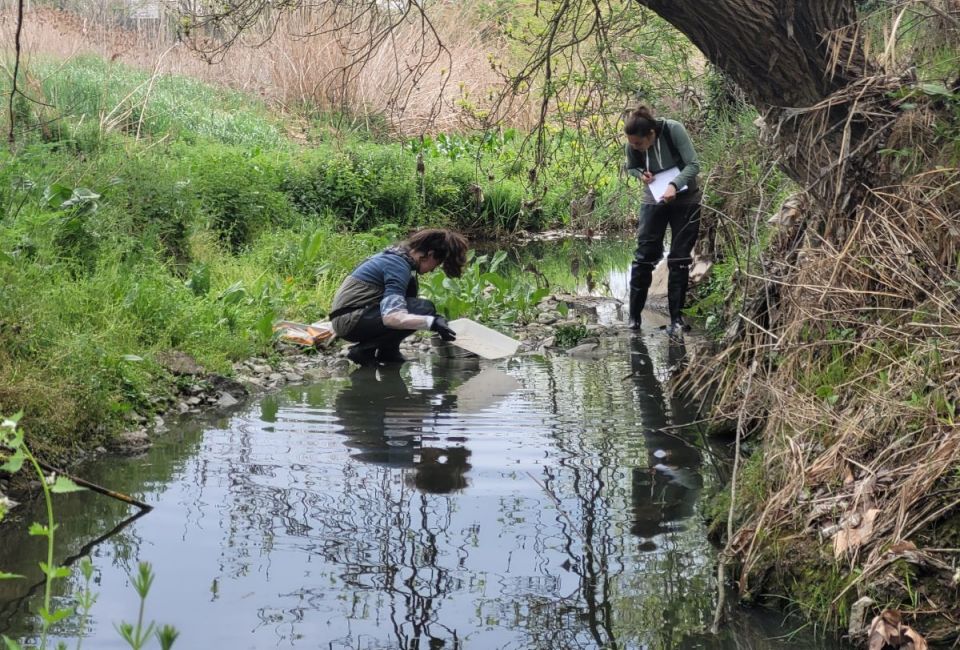
The decline in the level of Osona's rivers and streams in 2023 reduces the availability of oxygen in the water for aquatic wildlife
The prolonged and persistent drought that Catalonia has been experiencing since 2021 has led to a decline in the levels and ecological quality of Osona's rivers and streams. The drop in water levels in the region's rivers means that only stagnant water remains. This consequently has lower levels of oxygen, which poses a threat to the survival of fish and aquatic macroinvertebrates. That is one of the findings of the recently published study EEOsona2023MRSC (uvic.cat) undertaken by the Mediterranean Rivers Studies Centre (MRSC) at the University of Vic – Central University of Catalonia (UVic-UCC), the environmental department of the Ter Museum.
Another piece of evidence highlighted by the study is that at times when water is scarce, the quality of Osona's rivers and streams is significantly affected by both direct and diffuse pollution. Discharges from sewage treatment plants and industries remain at the same levels, but the pollutants they contain cannot be diluted in the water, and become more concentrated. The MRSC also observed an increase in nutrients in the water in 2023. This increase, which is particularly marked in the summer, at times of high levels of insolation and high temperatures - can lead to an increase in algae, which is also dangerous as it leads to the disappearance of fish and macroinvertebrates.
Aspects studied and proposals for improvement
The MRSC study confirms that the biological quality of the water obtained during the study of aquatic macroinvertebrates in Osona's rivers and streams has been in constant decline since 2021. Although this deterioration was apparent in 2022 in some stretches of the Ter and the Riera Major stream sampled where the quality is normally good, the decline was confirmed in 2023 in practically all the sampled stretches of the river Ter and the river Ges at Forat Micó, where the water did not attain the quality parameters of the previous years, despite its good quality.
The physicochemical parameters (electrical conductivity, dissolved oxygen, pH and nutrients) in 2023 also confirmed the general decline in quality. However, the main course of the river Ter, the river Ges at Forat Micó and the Riera Major stream had good or very good levels of quality for most parameters (with some exceptions) while the quality ratings for the Meder, Gurri and Rimentol rivers were between average and poor. There were very high concentrations of nutrients in most stretches last year, and a very low concentration of oxygen due to the decline in water levels.
The quality of the riparian forest in 2023 remained similar to previous years, with categories ranging between average and good. The rivers running through more urban or agricultural areas, such as the Gurri, the Meder and the Rimentol, obtained low values for this parameter, and their riparian forests showed significant levels of deterioration. However, the rivers in a more natural condition and headwaters had a more consolidated riparian forest of very good quality.
In view of these results, the MRSC has put forward some proposals aimed at improving the quality of water in Osona's rivers and streams. These proposals include applying fewer fertilisers to fields with crops, changing in the yardsticks used to measure discharges from sewage treatment plants at times of low water levels, and the restoration of riparian forests to help filter nutrients from fields with crops.
Sixteen stretches of river included in the sampling
The results of the report come from the samplings carried out in the spring and summer of 2023, in which several hydromorphological, physicochemical and biological parameters were studied in a total of 16 stretches of river in the Ter river basin in the Osona region. Six new sampling points have been added since 2021: three by Liquats Vegetals, SA; one by Aigües de Vic, SA and two by the Les Guilleries-Savassona Natural Area Consortium.
The MRSC has carried out a regular assessment of the ecological state of Osona's river courses since 2002 to study their evolution and remedy any problems that may arise if necessary. In 2023, the MRSC's annual study continued to receive support from the municipal councils of Vic and Manlleu, as it has done since its inception, and it was assisted by the Depuradores d'Osona, S.L. laboratory at the Vic Wastewater Treatment Plant.
Full information is available in the document EEOsona2023MRSC (uvic.cat)